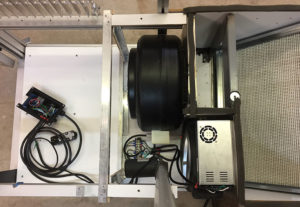Improving medical care often involves remodeling, expanding, and updating facilities. Completing these facility improvements presents many challenges, primary among them is how to do this work effectively while maintaining safety for patients, staff, and visitors. In our case, meeting our most recent challenge required innovating existing materials to develop a smaller Dust Containment Cart for use in hospitals and clinics.
There may be two questions that come immediately to mind:
1) What’s a Dust Containment Cart?
2) A smaller Dust Containment Cart?
A dust containment cart is a mobile device with adjustable walls that allows a person to work above the ceiling, without exposing the surrounding rooms, hallways, and air, to potentially harmful materials resting in the ceiling dust.
The dust cart acts as a barrier, and in most cases, a filtration middleman, between the dust interacted with above the ceiling and the primary care level where patients and staff reside. Often times, the work that is necessary to maintain and update the safety and performance of healthcare facilities requires contractors, engineers, and other facilities teams to go above the ceiling to check system functions. When this happens, they disturb the dust.
In many buildings, what happens is that mold spores and other contaminates that get in the air stream get deposited above the ceiling and lay there relatively dormant until they’re stirred up. Once this occurs, those spores and contaminates can find moisture or some other host that can cause the particles to become active again. It’s necessary to filter the air and contain the dust when working above the ceiling so that vulnerable populations within that facility are not exposed to additional harms.
NWESI’s New Dust Carts
NWESI has been using dust carts for a number of years, but was recently confronted with the challenge of working in smaller and more congested patient rooms. We needed to maneuver this cart among various doorways, space between beds and patients, and ensure there was enough room to maintain patient care.
The standard dust cart size available to us from manufactures was too large for this purpose; using that size would take more time to work through each space, and in some cases would not fit into the areas at all. However, we still needed to complete our work on the systems.
Our solution? Make it smaller.
Our Site Sustaining Division Manager, Bruce Gilpin, modified one of our existing dust carts to suit our needs and maintain the hospital air quality during our scope of service. The cart was re-sized by shortening the cart 14” and reducing the width by 8”. This 40 percent reduction in floor area allows the cart to be positioned more efficiently, reduces the impact to the patients and staff, and improves our efficiency in completing our service.

Having our own dustcarts also ensures that we have control of the quality of dust cart we use. Maintaining our carts includes testing the air filter as required, cleaning the interior and exterior of the cart appropriately between work sites, and making sure we have all supporting supplies needed.
NWESI has also invested in an enclosed trailer allowing us to take dust containment carts to smaller community healthcare facilities that may not have this resource.
As healthcare facilities continue to improve, we’ll be anticipating new challenges and how we can improve our services to meet their needs. Working to minimize patient exposure to infection risks will be paramount in our thoughts, as NWESI is dedicated to ensuring that we provide services that keep patient safety in the forefront of our work.

Published February 2020



